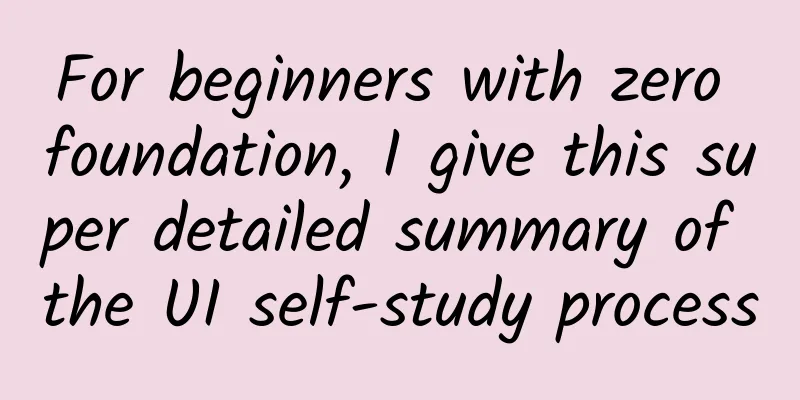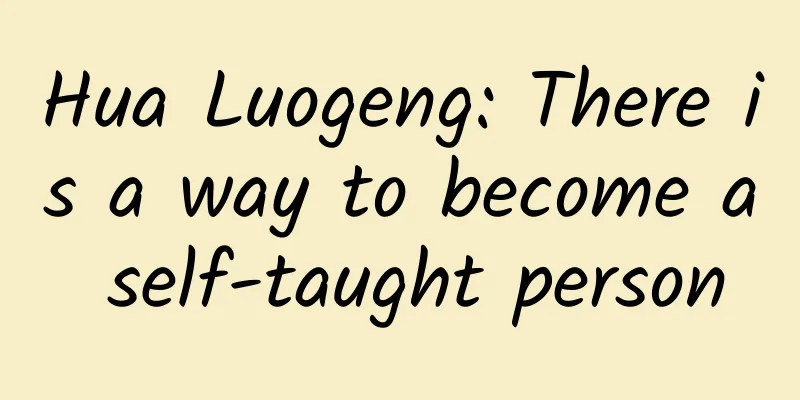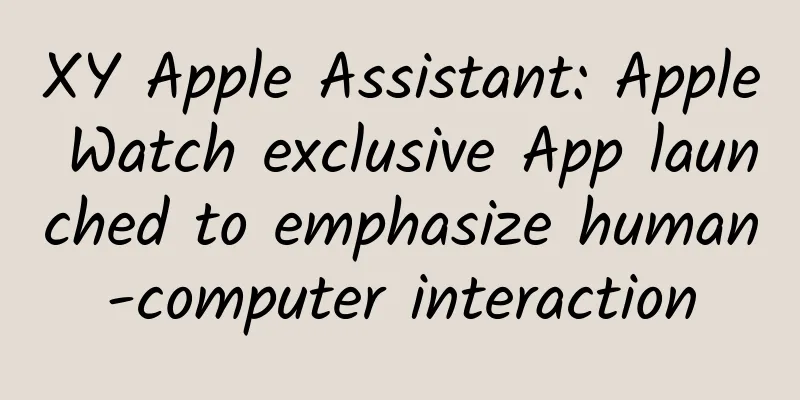For beginners with zero foundation, I give this super detailed summary of the UI self-study process

|
A few years ago, I wrote a long article about learning UI from scratch, answering "Super Practical Beginner's Guide! How to Self-study UI Design from Scratch?". After so much time, I have come into contact with many new people, including students in my own courses, and my ideas have changed a lot. Which system is more suitable for students with high perseverance, sufficient time and a good mentality (to put it bluntly, it is almost suitable for freshmen and sophomores). Most people want to see quick results and a short learning effect feedback cycle. It is useless for newcomers to learn hand-drawing directly, and it is also useless to read books randomly and not really regard reading as learning! So in response to this demand, I have given a new answer, see below for details. To become a UI designer, you must first understand what skills are needed to solve problems in your daily work. However, for different companies and different career stages, the problems we have to deal with are different and vary greatly. This covers a very wide range of skill types, from print advertising to 3D modeling and animation special effects. Especially in small companies, it is necessary to have multiple roles. For example, in a small outsourcing company, the designer may have to contact the client as a project manager in addition to producing drawings, or he may have to write the front-end code himself when making a web page! This is unavoidable in any profession. The smaller and lower the level of the company, the less likely it is to maintain singleness in the work content. Of course, because the working environment in these companies is not ideal, the work is miscellaneous and different from what they imagined, so when these designers express their opinions, they often complain bitterly, citing other skills required in the work and being exhausted every day. Over time, some people summarized these related skills and made complex mind maps, similar to the one below. Is every skill in it useful? Of course, it is. We can even write a long article to analyze each skill and list various data to tell you its importance. However, we cannot learn all of them in the early stage. For many skills, you cannot evaluate when you have "learned" them and to what "level" you have learned. This is the biggest trap for newcomers and junior designers. They are keen to collect all aspects of the profession and then learn them without any plan. For example, the explanation of design psychology on the Internet is generally superficial. You either read Norman's "Design Psychology" series or learn the knowledge of design-related psychology. The psychology that is truly related to design must be understood from the physiological level, such as how the retina forms an image, how the visual cortex works, and the reaction of consciousness to graphics and related behaviors. Without systematic deconstruction of related knowledge, it is impossible to smoothly apply them to real projects. Especially for newcomers who want to enter the industry quickly, if all your time is spent on learning skills that cannot be directly applied to projects or are not easy to produce results in the short term, then the time it takes to enter the industry will be greatly extended and the speed of progress will be extremely slow. Newcomers should first understand the most common work output and requirements of junior designers, and then formulate the core skill learning scope. Design psychology and illustration hand-drawing skills are all expanded according to actual conditions after you have achieved the core skill requirements and can find a job. Next, I will start from the most common work output content in the industry, to the required level, and how to learn, to explain which skills junior designers should learn first, so that you can avoid some detours. 1. General Work Output First of all, the main outputs of UI designers include the following categories: APP-related design, product homepage design, management interface and advertising images (in the interface advertising space), which account for the vast majority of the work. Then there are the design types that UI designers may encounter in their work, such as H5, LOGO and VI, offline materials, PPT, product refinement, etc. The main work output type is the core indicator for judging the ability of junior designers, and determines our application and work performance. Of course, you may say that many companies write the position as UI but are doing graphic design or other work. Those special cases cannot represent the whole. Even if it is a recruiter, if the performance of the main output of UI in the resume exceeds expectations, the requirements for other secondary skills can be lowered. Usually, if these things can be done well, then other types of things should not be too far behind. This is the real idea of the recruiter. In real recruitment experience, if the employer's requirements for programming, hand-drawing, and graphic design are ranked ahead of UI, and your value is measured by those skills, then with all due respect, this position is just recruiting a front-end designer (or illustrator, graphic designer) who knows a little about UI. The company may not have thought through its recruitment needs from the beginning, or may not have clearly distinguished the difference between UI and other types of work. Don't let these situations disturb your mood. In reality, most junior UI designers on the market have not made any useful contributions in the main types of design they produce, and their standards are worrying, so it is quite easy to do better than them and exceed the average level in these areas. Designers who can make designs like the following are the ones who are ready to be replaced by newcomers and shout that the industry is failing. By the way, the best way to develop a comprehensive design is to expand after you have mastered one or two skills and cannot be easily replaced by others. Not only is it easier to learn, but you can also use the knowledge points and thinking methods in other directions to drive the progress of your best field, rather than starting work at the same time. This is why excellent teams and designers are far better than mediocre designers with several years of experience in certain design types when they are facing them for the first time. Most people, even adults, never achieve a sufficient level of skill in any domain to allow them to feel the true power of mental representations to plan, execute, and evaluate their performance as the elites do. As a result, they never really understand what it takes to achieve that level of skill, not just time but quality practice. Once they understand what they have to do to achieve that high enough level of skill in one domain, they understand, at least in principle, what it takes to achieve excellence in other domains. —Anders Ericsson So let’s take a closer look at what specific content should be designed in the main output. 2. Specific Outputs 1. Mobile APP UI APP interface
Interface Icons
Interactive Prototype
Basic animation (lower weight)
Annotate Cut
Design Specifications
2. PC web interface Web interface
Management interface (except for specific industries with lower weight)
Annotate Cut
3. Advertising pictures Banner design
H5 activity page (low weight)
3. Software Learning The above output content covers the work of most early UI designers. Next, we will analyze the software and knowledge points to be mastered based on the requirements of these design contents. 1. PhotoShop Photoshop is the beginning of our learning of design software. Being familiar with its interaction, functions, ideas, and professional terms is crucial for us to quickly learn other design-related software. Moreover, in the work of graphic design, PS is also a software we will inevitably use. As a giant, it is impossible for us to learn all its functions in the early stage, so we must select the appropriate functional modules. Create Save How to create the right canvas, understanding of resolution and color modes, and what are the knowledge points of different saving modes. Related Tools The functions and operation methods of the basic tools in the toolbar. Pen Path How to use the pen tool in PS and how to operate Bezier curves. Layer properties The specific functions of each option of layer properties and the corresponding application scenarios are mainly studied in depth in skeuomorphic design. Color adjustment function PS color-related functions, such as channels, hue adjustment, curves and other tools. Filter function Learn about several common filter types and their related applications. Boolean operations How to use Boolean operations on paths to draw graphics. Character Settings All settings about text layers in the Properties and Paragraph panels. 2. Adobe Illustrator AI is the twin brother of PS. They look very similar, but they are aimed at different purposes. It is easy to learn once you are familiar with PS. In the early stage, you only need to focus on the design of graphics and icons. After screening, there are not many things we should master. Create Export The knowledge about file creation is the same as that of PS, but the relatively more complicated artboard rules should be understood as clearly as possible, and the differences between Ai saving and exporting should be distinguished. Pen Path Compared with PS, Ai's path processing is more complete and diverse, with practical functions such as path finder, deformation tool, manipulation deformation tool, rounded corner controller, etc. Color Fill The color filling method, gradient application, and grid filling method in Ai. Canvas Ruler Ai canvas related settings, rules for using the ruler tool, and how to assist us in creation. 3. Sketch, XD Compared with the previous two, these two softwares are not difficult to use. Once you are familiar with PS and Ai, you can get started in a few days. And they are the most friendly in supporting UI design, with fast speed and high efficiency. You can choose one of them as the main focus. 4. Blue Lake, Markman, SketchMeasure These software are used for annotation, cutting and collaboration. After understanding the knowledge related to cutting, it only takes a little time to learn how to use them. 5. AE, Flinto optional 6. Powerpoint, Keynote PPT is a must-have in the workplace, and designers should use it better than ordinary people so that they can better present our ideas and designs to others. 4. Theoretical knowledge After understanding the relevant software learning objectives, we should then know what theoretical learning should include. 1. Art Theory Art theory is not something that can be mastered only through learning sketching. Daily practice and observation can help us improve our foundation in art theory. Light and shadow Have a deep understanding of the effects of light on objects, including highlights, backlights, reflections, dark areas, etc. And know how to analyze the strength and levels of light and dark in the picture. Composition Tips The composition of art and photography is basically the same, and some basic geometric composition methods are required. Perspective Relationship Understanding various types of perspective, such as parallel perspective, angular perspective, and oblique perspective, will help you discover errors in the use of perspective in your own creations. Color Principles Basic knowledge of colors, and how to match different types of colors through the color wheel, such as contrast, proximity, similarity and other color matching principles. 2. Plane theory Four elements of plane The four elements of alignment, intimacy, contrast and repetition are the most basic theoretical knowledge in our design and the top priority of UI design. The first half of "Graphic Design Book for Everyone" has a more detailed explanation. Principles of plane geometry In addition to the golden ratio, if you want to understand how to design and create through geometric mathematical derivation, I only recommend reading "Geometric Principles in Graphic Design". Font recognition The design principles and understanding of various basic fonts such as Chinese, English, serif and sans serif, as well as the attribute settings contained in the text, such as line height, font weight, etc., and their impact on reading and interface. Grid system For knowledge points about how grids are set up and how they work in typesetting, you only need to read "Grid System in Graphic Design". Printing Settings When designing content that needs to be printed, how should PS and AI set up and export the canvas? 3. UI Theory Aesthetics of the Works Be able to distinguish between excellent and poor designs, and comment on them through basic graphic theory. Before starting specific design, you can have a higher pursuit of quality and analytical ability support. It is recommended to create a drawing board on Huaban to continuously collect excellent works. Resolution Knowledge related to screen resolution, and a clear understanding of the differences in pixel ratios of different systems and mobile phones. Design Specifications Know the design specifications for web pages, iOS, Android and other platforms, and how to create conservative and error-free designs. Control Type Understand the mainstream control types, and know the states and practical application scenarios contained in different control types. Component Type Understand the mainstream component types, know what types of components are used in specific industries or functions, and their related interaction logic. Cutting diagram annotation After completing the design, how to make corresponding annotations on the design, as well as the purpose and method of cutting the picture. Animation knowledge The mainstream interactive animation types in APP, as well as animation-related implementation parameter types, including easing and animation curves. 5. Work efficiency 1. Project Process The mainstream APP team project development process, what processes will be experienced from project establishment to launch, and what specific tasks different roles in the team are responsible for. Have a certain introductory understanding of collaboration methods such as Agile, Lean, and OKR. 2. Design Process When we start our design work, how to use the correct planning and execution steps to ensure the maximum utilization of capabilities and the improvement of efficiency. 3. Time and energy management In fact, this should be written first, but in order to avoid being abrupt, I put it at the last point to emphasize that in order to ensure learning efficiency, time management has a higher priority and is more important than learning any of the previous skills. After understanding how to allocate time, you must use some tools to help you plan your learning process and assign tasks, such as mind mapping tools Xmind, MindNode, and To-Do-List tools Things, TickTick, Crazy Tomato, etc. 6. Misunderstandings 1. A reply First of all, someone posted this kind of question in the comment area. Basically, they wanted to be naughty without reading the answer carefully! First of all, this will be eliminated within one year. These things are not enough for designers who want to go far, but remember the mind map I put earlier. After the core skills are solid, you can pursue and learn other things! Why would you stop by yourself and wait to be eliminated after a year without any progress? Let’s not talk about the so-called UI position where 1,000 people applied for it. He has experienced it several times or received resumes himself! Just look at the quality of resumes generally received by BAT juniors and interns. Those who want to fully meet the requirements I mentioned above are still rare! Many people like to follow the crowd, exaggerate the difficulty of the environment, and then do not provide solutions, and show themselves in various ways! After all, UI is a visual job. No matter where you submit your resume, our top priority is the quality of your work, which represents your professional ability! If you don't judge by your work, but only by your education, major, or so-called artistic literacy, then this kind of team is not recruiting employees who can do things. What you need to do is to use efficient learning methods to develop a solid foundation, and then crush those who boast of their so-called artistic literacy! If you learn randomly, you will never have a chance! 2. Skill Tree Many people feel panicked when they see the skill tree, which is quite puzzling to me! I used that picture as a negative example! It's wrong! It's wrong! It's wrong! You must accept that each major can expand a vast number of skills, but they are useless for your current stage. When you start to advance in the future, you will only need to take some of them to improve, not all of them! 3. About reading I will soon write a more formal answer to explain this. After reading my answer, many people in my group's first reaction is to buy theoretical books. However, the places where I mentioned books are all in the later part of the process. They are anxious about the later things before they have done the previous ones. To put it bluntly, they resist the difficult parts and only tackle the simple things, because the cost of reading books is too low and too easy. So, don't worry about the books. Read the answers carefully, spend a day or two thinking about it, make a good study plan, adjust your work and rest schedule, and then roll up your sleeves and get to work! Conclusion The above is my thinking on how to improve my UI design ability and change careers as quickly as possible. Only with a clear goal can we know how to practice and have the courage to conquer these blind spots of knowledge. |
>>: A comprehensive summary of design anomalies and how to handle them
Recommend
Back to the South, smart door lock "suicide" incident
If you ask who has the most profound understandin...
How much does it cost to create a homestay mini app in Zhengzhou?
How much does it cost to produce a Zhengzhou home...
16 Lectures on Cosmology by Professor Zhao Zheng from the Department of Physics, Beijing Normal University
Introduction to Professor Zhao Zheng's 16 Lec...
As users, we can be well prepared, but when we are in a relationship, it is really difficult if the other person changes every moment.
I seldom mention my love life in my articles. Fir...
"I know Metasequoia. We have a lot of them planted there." "Oh, it's endangered."
Friends living in the Yangtze River Basin have al...
Why is mobile banking important to the banking industry?
With the popularity of mobile banking, people hav...
The crisis is coming! Social media has all collapsed, and marketing is failing
Over the past few years, I have been watching and...
How to continuously obtain seed users?
There are many techniques for acquiring seed user...
The plant world is experiencing an unexpected phenomenon: cattle and sheep can reduce grassland diseases by eating it
Produced by: Science Popularization China Produce...
Meizu App Store promotion information flow advertising delivery process and billing method!
1. Introduction to advertising types 1. App Store...
NASA finally admits! Going to Mars is to search for alien life
As to whether there is extraterrestrial life in t...
Meizu Blue has been released, but has Meizu figured it out?
For a good product, why must I rely on low prices...
Apple's new iPhone production this year is 65 million, the lowest in four years
At 1 a.m. Beijing time on September 11, Apple wil...
At the age of 45, he solved a century-old problem with a paper, and at the age of 85, he stood on the country's highest science and technology podium
From traveling across mountains and rivers to car...
After 20 years of gene sequencing, we finally figured out what junk DNA is for
In 1990, the international human genome project w...









